With the rapid development of science and technology, human beings have never stopped pursuing night vision. Since the birth of night vision technology in the early 20th century, night vision devices have expanded from the military field to multiple application scenarios, such as security monitoring and ecological research. However, traditional night vision devices can usually only present a single green image, and this limitation has been a major challenge in the field of night vision.
The emergence of full-color night vision devices has brought a breakthrough solution to this challenge. Through advanced optical systems and image processing technology, full-color night vision devices can capture and present real color images in extremely low light environments. This innovation not only enriches people's visual experience, but also brings new possibilities for research and application in multiple fields.
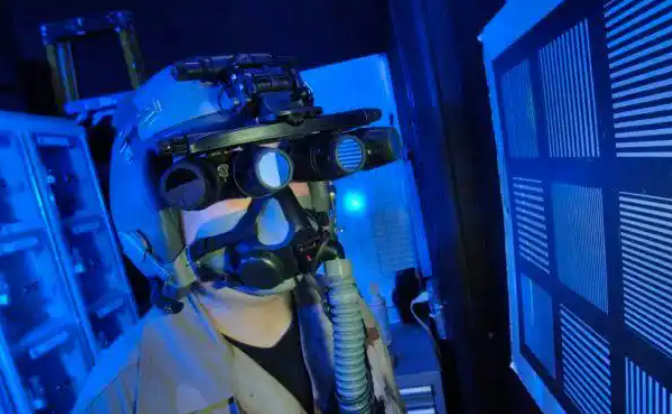
This article aims to deeply explore the basic working principle of full-color night vision devices, comparative analysis with traditional green night vision devices, and potential applications in broader fields in the future. Through scientific analysis and evaluation, we will reveal the value and potential of full-color night vision devices as a cutting-edge technology, and provide a useful reference for future research and development.
As an innovative technology, full-color night vision devices break through the traditional limitations of the night vision field by capturing and displaying real color images. This section will explore the working principle, components and technical features of full-color night vision devices in depth.
1.1 Working principle
The working principle of full-color night vision devices involves multiple fields such as optics, electronics and image processing. The main steps include:
Optical acquisition: Capture weak light, such as starlight, moonlight, etc. through special lenses.
Image enhancement: The sensor converts light into electrical signals and enhances them through image processing technology.
Full-color conversion: Retain and process the color information of the image to present a full-color image.
Display output: Present the enhanced full-color image through a screen or other display device.
1.2 Component structure
The main components of full-color night vision devices include:
Optical system: Lenses, optical filters, etc., responsible for focusing and collecting light.
Image sensor: Such as CMOS or CCD sensor, converts light signals into electrical signals.
Image processing unit: Responsible for image enhancement, color processing and noise reduction, etc.
Display device: Such as OLED screen, used to display the processed full-color image.
1.3 Technical Features
The main technical features of full-color night vision devices include:
High sensitivity: able to work in extremely low light conditions.
Full-color display: provides color images close to natural vision.
Multi-function integration: can be combined with augmented reality, navigation and other technologies.
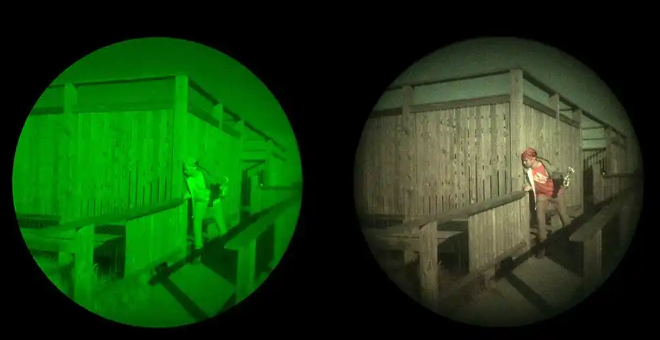
1.4 Conclusion
Full-color night vision devices achieve full-color vision at night through advanced technology, which not only enriches the visual experience, but also provides new solutions for multiple fields. It is a model of cross-integration of visual science and technology, and demonstrates the innovative potential of modern science and technology.
Part II: Comparison of the difference between full-color night vision devices and traditional green night vision devices
Abstract
The difference between full-color night vision devices and traditional green night vision devices is not limited to visual experience, but also involves technical implementation, functional application, and user experience. This section will explore these differences and the advantages of full-color night vision devices through detailed analysis and comparison.
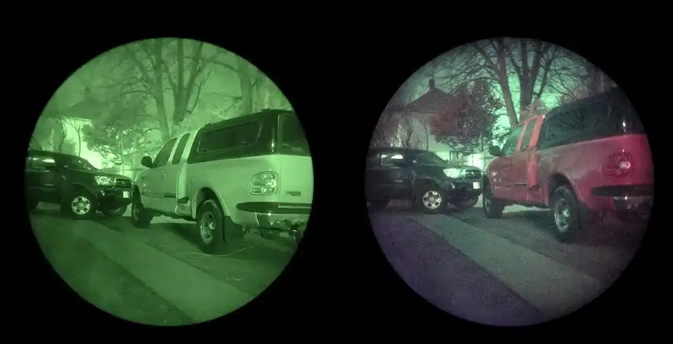
2.1 Visual effect comparison
2.1.1 Color reproduction
Full-color night vision devices: using advanced sensors and image processing algorithms, can present real color images.
Traditional green night vision device: usually uses light enhancement technology, resulting in a green monochrome image.
2.1.2 Resolution and clarity
Full-color night vision device: provides higher resolution and clarity through optimized optical design and image processing.
Traditional green night vision device: resolution and clarity may be limited by technology and cost.

2.2 Technical implementation comparison
2.2.1 Sensor technology
Full-color night vision device: uses a high-sensitivity color sensor combined with advanced noise reduction algorithms.
Traditional green night vision device: mainly relies on light enhancement tubes and may not be able to capture full color spectrum information.
2.2.2 Image processing
Full-color night vision device: uses complex image processing technology, including color balance, sharpening, contrast enhancement, etc.
Traditional green night vision device: image processing is relatively simple, mainly focusing on brightness enhancement.
2.3 Function and application comparison
2.3.1 Application field
Full-color night vision device: suitable for military, security, outdoor, scientific research and other fields.
Traditional green night vision goggles: Mainly used in military and security fields.
2.3.2 Integrated functions
Full-color night vision goggles: Can integrate advanced functions such as augmented reality, navigation, and remote control.
Traditional green night vision goggles: Relatively single functions and limited expansion capabilities.
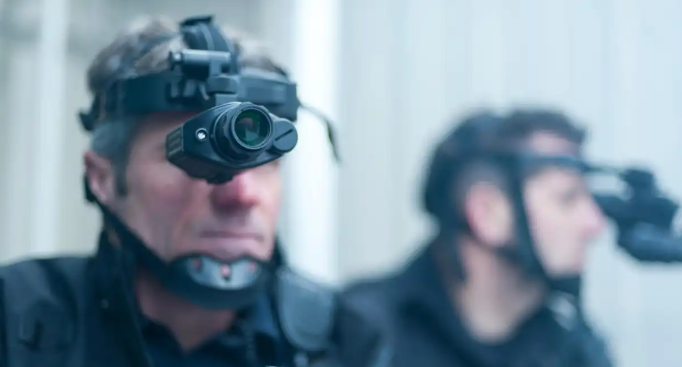
2.4 Conclusion
Compared with traditional green night vision goggles, full-color night vision goggles have significant advantages in visual effects, technical implementation, and functional expansion. It not only provides a richer visual experience, but also promotes the widespread application and innovative development of night vision technology.
Part III: Looking forward to the greater role and application scope of full-color night vision goggles in the future
Abstract
As a cutting-edge technology, the role and application scope of full-color night vision goggles in the future will far exceed the existing fields. This section will look forward to the future potential and challenges of full-color night vision goggles from the perspectives of military, security, scientific research, and commercial applications.
3.1 Military field
3.1.1 Tactical operations
Night battlefield management: Provide full-color real-time monitoring to help the command make accurate decisions.
Special forces operations: Improve the accuracy and safety of night missions.
3.1.2 Strategic deployment
Remote reconnaissance: Remote reconnaissance through drones equipped with full-color night vision devices.
War simulation and drills: War simulation using full-color night vision devices in a virtual reality environment.
3.2 Security monitoring
3.2.1 City security
Night patrol: Police vehicles and drones equipped with full-color night vision devices improve nighttime urban security.
Major event security: Use full-color night vision devices for security monitoring at major events such as sports games and summits.
3.2.2 Border control
Border patrol: Combined with artificial intelligence analysis, full-color night vision devices can be used for automated border patrols.
Smuggling prevention: Monitor smuggling activities through full-color night vision devices and take timely measures.
3.3 Scientific research
3.3.1 Nighttime ecological observation
Animal and plant behavior research: Observe the behavior of animals and plants at night through full-color night vision devices without disturbing the natural environment.
Meteorological and astronomical observation: Used to observe nighttime meteorological phenomena and astronomical objects.
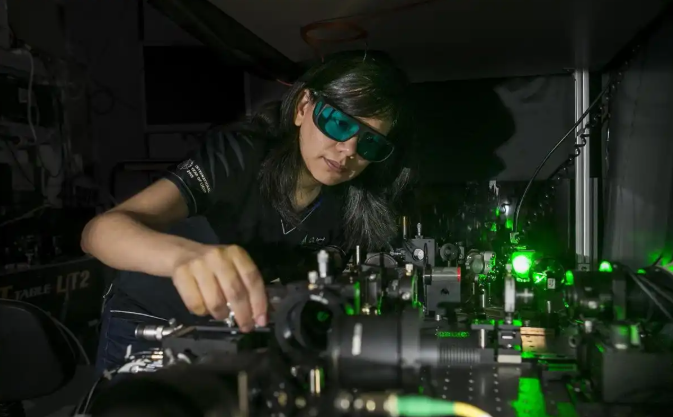
3.3.2 Deep-sea and space exploration
Deep-sea biological research: Use full-color night vision goggles with submersibles to observe deep-sea ecology.
Space station monitoring: Use full-color night vision goggles in space stations to monitor equipment and external environment.
3.4 Commercial applications
3.4.1 Consumer electronics
Outdoor sports equipment: Outdoor sports cameras, telescopes, etc. combined with full-color night vision goggles.
Smart home security: Integrate full-color night vision goggles in smart home systems for nighttime security monitoring.
3.4.2 Industrial automation
Nighttime production monitoring: Monitoring and management of factory automated production lines at night.
Logistics and transportation: Use full-color night vision goggles in nighttime logistics and transportation to ensure transportation safety.
3.5 Conclusion
Full-color night vision goggles have a wide range of future application potential and applications, and will play a key role in military, security, scientific research, and commercial fields. However, they also face technical challenges and ethical considerations, which require further research and exploration.


